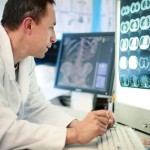Researchers develop imaging technology to see through metal orthopedic screws
Broken bones are not only painful, but the healing process can also be long and arduous as patients experience a marked decrease in mobility. When a joint is involved in the process, this can pose serious issues, as it must be immobilized to allow the body to heal itself without interruptions.
For hip fractures, one of the most common injuries sustained by people in the U.S. aged 65 and older, orthopedic surgeons often implant metal screws to grant more support to the rebuilt joint. However, when physicians need to check on the condition of the healing process through a magnetic resonance imaging machine, these screws can cause distortions that make it difficult to see just how the bone has regrown, among other complications.
According to the results of a study announced at the annual meeting of the American Academy of Orthopaedic Surgeons, however, researchers from the Hospital for Special Surgery in New York have developed a technique that allows MRI machines to accurately scan joints that have metal surgical screws with little to no distorting effects.
A clearer picture
The study looked at patients who had suffered a type of hip injury known as a femoral neck fracture, in which the top most protrusion of the femur has cracked or snapped. Because this part of the bone is so critical in the movement of the leg within the hip joint, metal surgical screws are often used to ensure that the whole structure heals properly.
According to the U.S. Centers for Disease Control and Prevention, 258,000 people in 2010 were admitted to hospitals for hip fractures, and this number is expected to climb to 289,000 in 2030.
While hip fractures are normally not life-threatening, a process known as osteonecrosis requires regular checkups by physicians. Depending on the type of fracture, the normal supply of blood to the bone may be interrupted. If bone cells do not receive enough oxygen and other nutrients in a timely manner, they may die and spread harmful materials to neighboring cells as well.
For this reason, it is imperative that physicians be able to accurately monitor the stages of the healing process without distortions caused by metal screws and other foreign objects. Early detection of osteonecrosis is key to reversing the effects of the process, and failure to diagnose it can lead to more surgeries.
A new perspective
Hollis Potter, M.D., chairman of the department of radiology and imaging at the HHS, said in a statement that a new MRI technique known as "multi-acquisition variable-resonance image combination" allowed him and his team to see through the metal surgical screws commonly used to set and stabilize hip fractures.
"This new MRI greatly improves the visualization of bone and soft tissue when there is metal in a joint, such as the screws used to repair a hip fracture," Potter said. "Our team is constantly optimizing the ability to image the earliest signs of a musculoskeletal condition, disease progression and/or healing."
Potter also explained that the quality of orthopedic surgery has progressed to such a high point that the majority of cases they examined with the new technique did not show evidence of osteonecrosis, but that the new technology has promise for the future.



